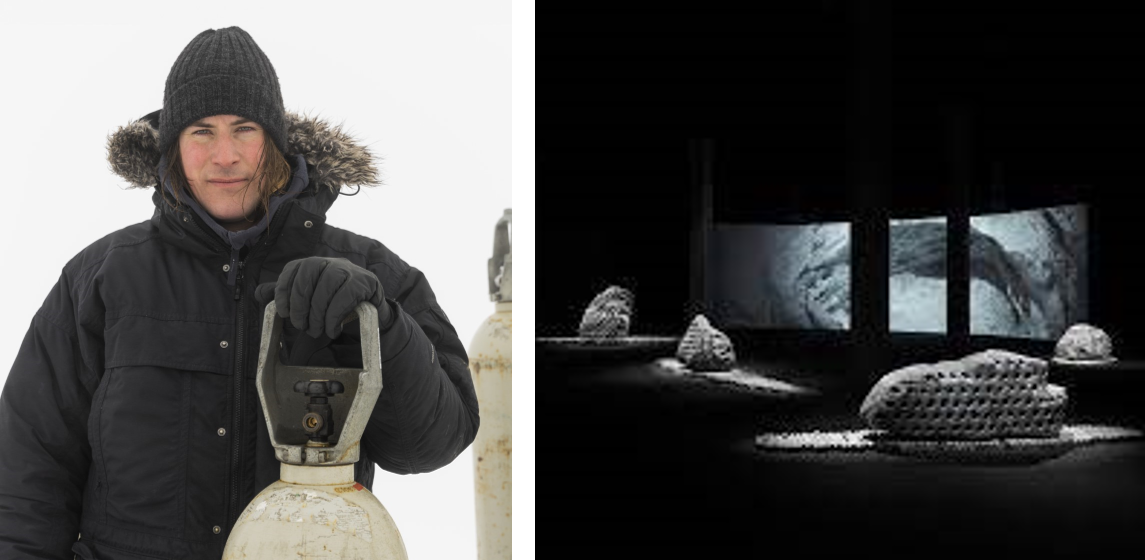How did environmental issues appear in your work? Was there a light-bulb moment, an influence?
There was no light-bulb moment. It happened very naturally. Very early on, I became interested in our relationship to space, to the world that passes through us and that we pass through. Working in the field, in the landscape, with matter, quickly became the driving forces of my approach. Of course, environmental issues are intrinsically involved in our relationship to the world. These issues have become increasingly important in the reading of my work over the years, even though they have been a constant in my practice.
Which approach have you chosen in the context of your selection for the Prix Marcel Duchamp?
It’s a project about celestial memory and the former states of the atmosphere, but also about the place of humans within these complexes, which are so gigantic as to escape us. The project takes the form of an immersive installation based around a central piece, a “pure waste” video, that documents an action taking place in the north of Greenland. In a gesture that is as provocative as it is reconciliatory, a hand throws a few diamonds into a glacial mill.The diamonds in question are quite unique. I created them using CO2 harvested during an inverted extraction operation, where instead of mining minerals from rock, I sucked up the dioxide from the surrounding air, and then mixed it with CO2 extracted from the breath of a thousand people from across the world, before transforming the carbon into its purest, hardest form, a diamond.

What lessons have you learned from extreme environments?
The human spirit has always been fascinated by extreme environments. Because of their inaccessibility, they are propitious environments for the development of my work. I am interested in the gap between the way in which we represent or project our knowledge onto an object, and the object itself, the gap between representation and reality. For what is reality without representation? Bikini Atoll and the nuclear tests that took place there are a perfect example. It has been one ofthe most photographed places in the world. It has become part of a collective visual memory. Most people think about a swimming costume when they hear the name Bikini. And yet the atoll remains a well-known place for many, and we know that nuclear tests took place there in the 1950s. The interesting thing is that no one knows where to find it on a map, nor what is growing on its surface 70 years later. That is what fascinates me. There is a huge gap between the physical reality of the place and its representation. There are therefore two places, two atolls: an imagined, phantasmagorical universe, and an island lost in the middle of the Pacific Ocean.
On the subject of Bikini Atoll, why did you choose to work on the nuclear theme?
There was a particular moment when I was looking into twentieth-century iconography, specifically the first images of the Earth taken from Space. Image-tools that enabled us to apprehend our planet in its totality, and which consequently gave us the possibility to reflect on its finite nature. This reflection led to the advent of ecological consciousness and eco-activism. At the same time, there were also the images of the atrocious violence of the atmospheric nuclear tests. This potential for total destruction, for the elimination of all life on the surface of the globe, perceived in its totality. And then there were the places where the tests were carried out, places which will forever be witnesses to our passing, to our presence. These kinds of places attract me, because they often include different temporalities.For me, they act as temporal bridges. A meticulous examination reveals their potential to open doorways to scales of time that the human spirit cannot grasp. On reflection, the duration of two generations is already very abstract, so how can we project ourselves into the thousands of years imprinted by the nuclear threat? I am compelled by chronologies that transcend the human imagination. The temporality of radioactivity is one example. This is why I decided to visit these exclusion zones. To expose myself to them, to try to understand them. Such areas as also windows onto potential post-human futures. Parentheses between reality and fiction, areas that are no longer, but that continue to exist.Then, of course, my projects developed in different directions. Making the invisible noticeable has remained one of my priorities. Intrinsically, radioactivity is a phenomenon that is mainly measured by sound – I wanted to render it in images.

What are the most important environmental issues for you?
Being able to close up the different chemical cycles which we have opened and disrupted. We must quickly instigate a circular economy, particularly in the energy sector. The great difficulty is that even in Europe, where most of the population shares the opinion that imminent change is necessary, this change has not materialized. We need much more radical and efficient policies, as well as truly global cooperation. Unfortunately, history has shown us few examples of such a dynamic. Taking action is the real issue. I think that we need to create new narratives for the twenty-first century, because we are still mainly working on blueprints inherited from the 1960s.
Conversation with Alice Audouin
October 2021
Credits: Photo of the artist, © Studio Julian Charrière, 2021 / Julian Charrière , Towards No Earthly Pole, 2019, courtesy of the artist / Julian Charrière , Coconut Lead Fondue – First Light and Pacific Fiction, 2016, Vue de Biocenosis21 exhibition, photos by Jean Christophe Lett and Barthélemy Thumerelle
Link to the artist ‘s website Julian Charrière
Find all the articles from Impact Art News n°33 – September 2021
To subscribe to Impact Art News (free): here

